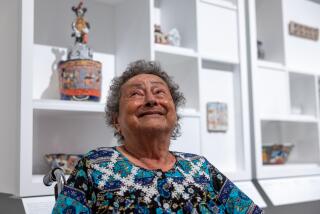Bursts of Art Elude Communism’s Grip
HAVANA — The drums call every Sunday morning, as compelling as church bells.
Ana Irma Carvajal invents an errand, ties a bandanna over her curlers and slips out of the upstairs apartment she shares with her invalid mother--”making up stories like a schoolgirl,” the 58-year-old retired salesclerk says, laughing.
She escapes to Callejon de Hamel--Hamel Alley--a block of brightly painted murals and outdoor sculptures in the working-class Cayo Hueso neighborhood. There, Carvajal, shopping bag slung over her shoulder, chats with neighbors and watches a new generation dance to the beat of traditional Cuban percussion with the murals as a backdrop.
Most Sundays, the alley fills with neighbors and visitors listening to the music, admiring the progress of the murals and immersing themselves in Cuba’s African-based popular culture.
Callejon de Hamel is Havana’s version of Watts Towers, a work of art in the middle of the old cigar makers’ neighborhood that tourists usually speed through warily on their way from flashy oceanfront hotels to the cafes and museums of colonial Old Havana.
The murals and the weekly rumba parties that Carvajal loves combine in the most visible example of artistic independence from the government and the Communist Party--which are nearly the same in Cuba and for nearly four decades have been the major patrons of the arts.
*
The artwork in the alley has been nurtured for six years by its creator, artist Salvador Gonzales, with the grudging tolerance of Cuban officials. “This comes from my desire to show my art to the people,” said Gonzales, his black beret and salt-and-pepper beard framing fine features and intense, dark eyes.
Gonzales painted his first mural in 1988, for Cuba’s African Cultural House, a government-sponsored center for Afro-Cuban culture. His interest in murals grew until two years later when, from his apartment overlooking Callejon de Hamel, he saw a new canvas: the filthy walls of an alley filled with trash.
He knew his desire to paint those walls would remain an unfulfilled inspiration if he waited for paint, never plentiful in Cuba and even more scarce during the years right after the former Soviet Union halted the subsidies that had sustained the island for decades. So Gonzales began by writing a poem on one of the walls in printer’s ink. He also hauled trash out of the alley for several days.
As people saw what he was doing, Gonzales said, “many neighbors took on the task of getting me a can or two of paint.” Mostly, the paint was left over from do-it-yourself household projects.
He used it for wall-high tributes to deities--Cuban versions of gods brought from Africa by slaves. Along with the murals, Gonzales built an altar to Chango, a principal deity in one of the three main Afro-Cuban religions that evolved from those slave beliefs.
“In Cuba, religion has been the form of cultural identity that has best preserved African culture,” said Nersa Caballero, editor of Matiabo, a Cuban magazine about Africa-based cultures. The murals express that identity in Cayo Hueso, with its largely Afro-Cuban population, she added.
The Sunday rumba parties reinforce that expression. Music--particularly drums and claves, or sticks--is as important to Afro-Cuban religion as cantatas like Handel’s “Messiah” are to Christianity.
Not everyone saw the art that way, at least not at first. “There were groups who disapproved of my work,” Gonzales said. “They thought it was a work of religious proselytism. My manner of expressing myself was controversial; it was weird.”
People who were obviously not tourists took pictures of the walls late at night. The chairwoman of the Committee to Defend the Revolution--the Communist Party equivalent of a ward boss--complained to him.
“Officially there was no censorship, but unofficially there was,” Gonzales said.
Still, five years earlier, the murals might not have been possible, Gonzales acknowledged. Cuba’s economic crisis has brought a change in thinking that includes more tolerance, he said.
“There has been a greater acceptance of community culture,” Caballero agreed. “New, low-cost cultural expressions became accepted with the economic crisis.”
As neighborhood efforts such as the one in Callejon de Hamel have sprung up, officials have recognized that they help combat the alienation that can come from city life, she said. “There is an acceptance that creativity does not exist only at the highest levels of the bureaucracy,” she said.
As a result, Gonzales said, “many eyes now see Callejon de Hamel as a work of art.”
*
He has made it a living work of art by inviting Clave y Guaguamco--a rumba group with a dozen members originally formed during the 1940s--to play on Sundays. The group plays an all-percussion style of rumba on brightly painted wooden boxes, using claves for punctuation. The group has modernized by adding 3-foot-tall drums, called tambores.
“We play for free because this is for the neighborhood,” said the group’s musical director, Amado de Jesus de Leu, 51. “This is ours.”
Fans range from De Leu’s 61-year-old mother-in-law, a tireless dancer who lives a block away, to a novice drummer so tiny that he can barely reach the tambores.
Not all the neighbors are enthusiastic about the clamorous Sunday celebrations. “I never have a peaceful Sunday because of this,” said a man who lives nearby.
But for Carvajal, a walk through Callejon de Hamel is the highlight of her Sunday. “This is a warm place--a cultural beacon,” she said. “This is ours, and I hope it will always be here.”
More to Read
Sign up for Essential California
The most important California stories and recommendations in your inbox every morning.
You may occasionally receive promotional content from the Los Angeles Times.










